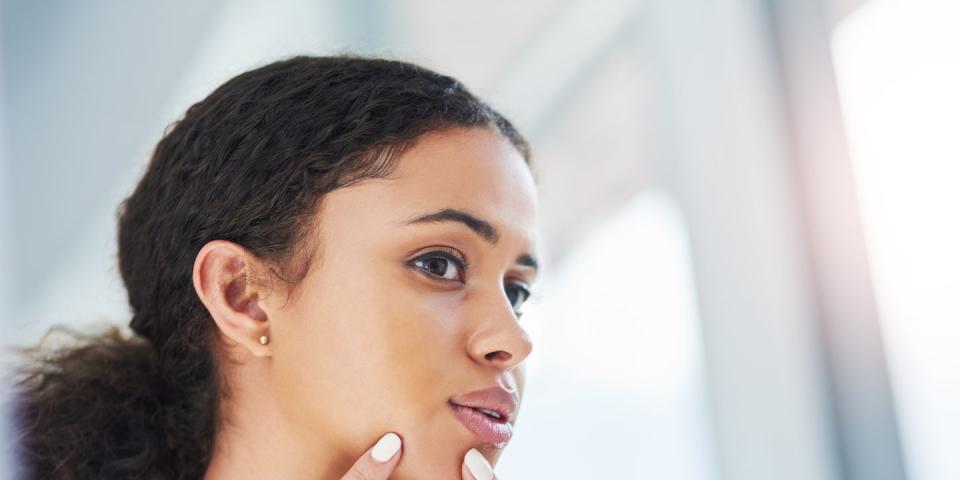Getting Rid of Pimples Has Never Been Easier With These Expert Tips!

Getting a big, red pimple on your face happens to everyone, but that doesn't mean you have to accept defeat and wait patiently until the blemish goes away. There are many ways to treat adult acne, but first it's important to understand the basics.
"We have sebaceous glands in the skin that normally provide moisture and lubrication, but the combination of stress and hormones can form clogs," explains celebrity dermatologist Dr. Marina Peredo. "The bacteria causes inflammation in the skin, which is why blemishes and acne form." And just like that, your skin flares up.
So, how do you free yourself of pesky inflammation? Here's how dermatologists recommend getting rid of those blemishes as soon as possible - and how to avoid making it worse. (However, if you need acne scar treatments to fix the aftermath of a troubling zit, there are many solutions to cure those as well.)
1. Hands off.
All dermatologists agree that you should never, ever pick at your pimple. We repeat: Do not pick at your pimple. "It may seem tempting, but remember that once you've picked at an acne lesion, it will take longer to heal and is more likely to scar," warns dermatologist Dr. Doris Day, author of 100 Questions and Answers About Acne. Trust us on this one.
2. Skip home "remedies."
While toothpaste, lemon juice and even Windex have been cited as excellent at-home remedies for blemishes, derms advise against them. "Toothpaste is more complicated than it used to be and can irritate or over-dry your skin," warns Dr. Day. "Lemon juice is also irritating and wouldn't have any effect on the pimple itself." And Windex - well, it's glass cleaner. Don't put glass cleaner on your face.
3. Apply a warm compress.
Heat is a super simple way to soothe your skin if you feel a blemish coming on, says Dr. Margarita Lolis, dermatologist at Skin and Laser Surgery Specialists of New York and New Jersey. "Use a warm compress or steam to bring everything to the surface," she explains. And once your pimple appears, apply a spot treatment. Alternately, you can use a cold compress to bring down the swelling of a particularly large, painful blemish.
4. Wash your face regularly.
"Your oil glands are active all day," explains Dr. Joshua Zeichner, Director of Cosmetic & Clinical Research in Dermatology at Mount Sinai Hospital; when that oil combines with dirt, makeup, and pollution, it's not doing your skin any favors. That goes double for workouts. "Sweat mixed with dirt and oil can become trapped under wet workout clothing," potentially worsening a breakout. "If you can't take a full shower," Dr. Zeichner says, "at least use a cleansing towelette," like Good Housekeeping Beauty Breakthrough Award winner and Seal holder Olay Daily Facials Daily Clean 4-in-1Water Activated Cleansing Cloths.
5. Apply a spot treatment.
On top of always washing off your makeup at night, using the right moisturizer for your skin type, and keeping your fingers away from your face, you can use a spot treatment to get rid of stubborn pimples. Ingredients to look out for: Benzoyl peroxide to kill acne-causing bacteria, salicylic acid to help exfoliate and unclog pores, and retinoids to help control cell turnover, which allows clogged cells to shed and prevents them from clogging.
6. In a pinch, get a cortisone shot.
Have a really big event coming up? Then, you probably don't have time to wait and see if your blemish will disappear on its own. Consider seeing a dermatologist for an overnight cure. "A cortisone shot is an anti-inflammatory, so it treats the pimple itself," explains Dr. Peredo. "If it's a big, painful pimple, the cortisone diffuses the inflammation and flattens it out, hopefully without leaving a scar." Of course, this isn't an easy, at-home DIY fix. It should only be administered by a physician, usually a dermatologist, and it is often covered by insurance if you have acne.
7. Try a salicylic acid cleanser.
If your breakouts are pretty frequent and you're sick of it, you may want to consider switching up your skincare routine. "Pick a cleanser that has glycolic or salicylic acid in it, which you can get over the counter," Dr. Peredo instructs. "Those with acne-prone skin may need an astringent to degrease the skin, too - I like salicylic or glycolic, because they can help with the scarring that could occur, as well."
8. Go light on your makeup.
Beauty products are one of the most common causes of adult acne, and unfortunately, using heavy duty makeup to hide your blemishes won't make them physically disappear. "Use mineral makeup on your skin rather than oil-based products that can contribute to breakouts," recommends Dr. Peredo, adding that oil-based foundation and concealer can be very occlusive. Better yet, go totally makeup-free for a few days - it could be just the break your skin needs to clear up quick.
9. Medicate if necessary.
For those who suffer from cystic acne, a combination of topical products, in-office treatments (like lasers), and medication are often times the way to go. A dermatologist can work with you to find medications that will help treatment in the long-run. "Nodular acne often requires treatment with systemic medications such as oral antibiotics, and hormonal medications (oral contraceptives, spironolactone)," says Valerie Harvey, MD, a dermatologist based in Virginia. "Isotretinoin, a derivative of vitamin A, is also very effective."
10. Turn to the light.
Instead of going to your dermatologist for red and blue light therapy (which can cost upwards of $100), use an at-home device over a blemish, or over your whole face, for just two minute. The red light reduces acne inflammation, while the blue light targets acne-causing bacteria. Additionally, the light stimulates the dermal layers of the skin and produce additional collagen. In turn, acne scars fill out and the skin looks more even-toned.
('You Might Also Like',)

